Abstract
1. The cardiorespiratory response to imagination of previously performed treadmill exercise was measured in six competitive sportsmen and six non-athletic males. This was compared with the response to a control task (imaging letters) and a task not involving imagination ('treadmill sound only'). 2. In athletes, imagined exercise produced increases in ventilation which varied within and between subjects. The mean maximal increase (11.71 min-1) was approximately 20% of the ventilatory response to actual exercise. This was primarily due to treadmill speed-related increases in respiratory frequency (mean maximal increase, 14.8 breaths min-1) and resulted in significant reductions in end-tidal PCO2 (mean maximal fall, 7 mmHg). These effects were greater (P < 0.01) than any observed during the control tasks. 3. Changes in heart rate (mean increase, 12 beats min-1) were not significantly different from those observed during the control tasks (P > 0.2). 4. In non-athletes, imagination of exercise produced no changes in cardiorespiratory variables. No significant differences were detected in subjective assessments of movement imagery ability between athletes and non-athletes (P = 0.17). 5. This study demonstrates that ventilatory effects, when observed, are specific to imagination of exercise. The greater likelihood of generating ventilatory responses in highly trained athletes, experienced in 'rhythmic' sports, may be related to awareness of breathing and its role in exercise imagination strategy. A volitional component of the response cannot be discounted.
Full text
PDF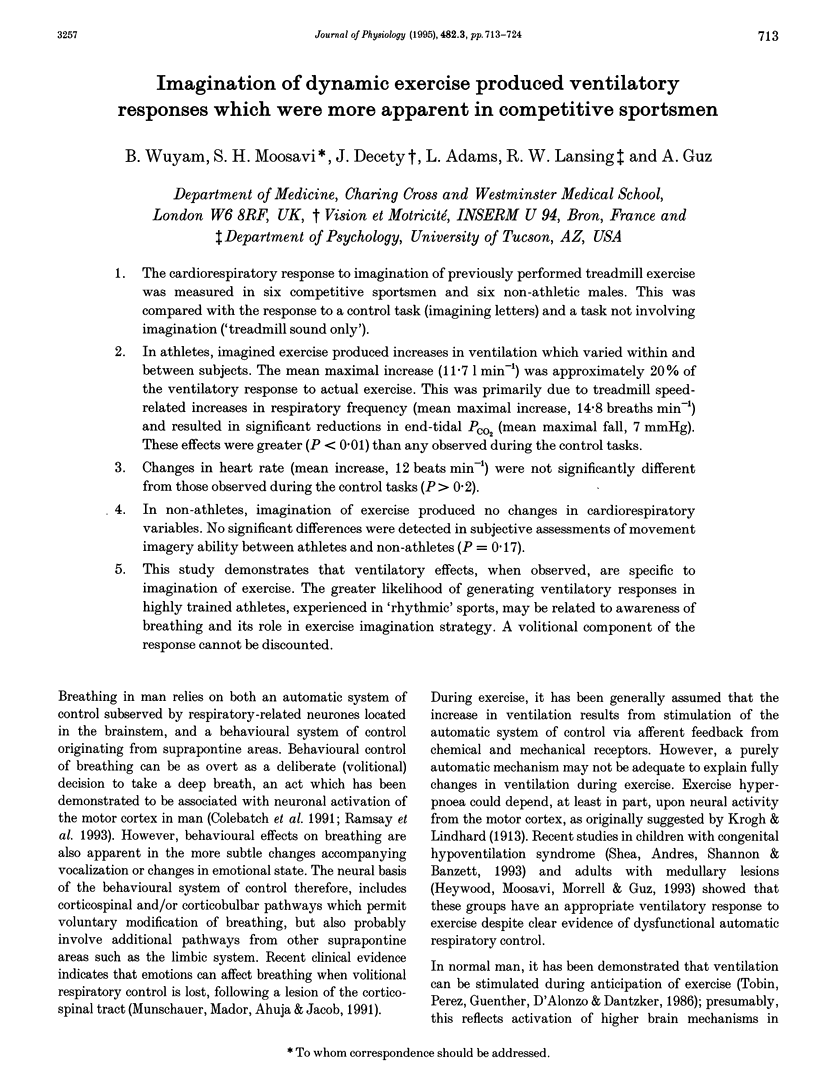
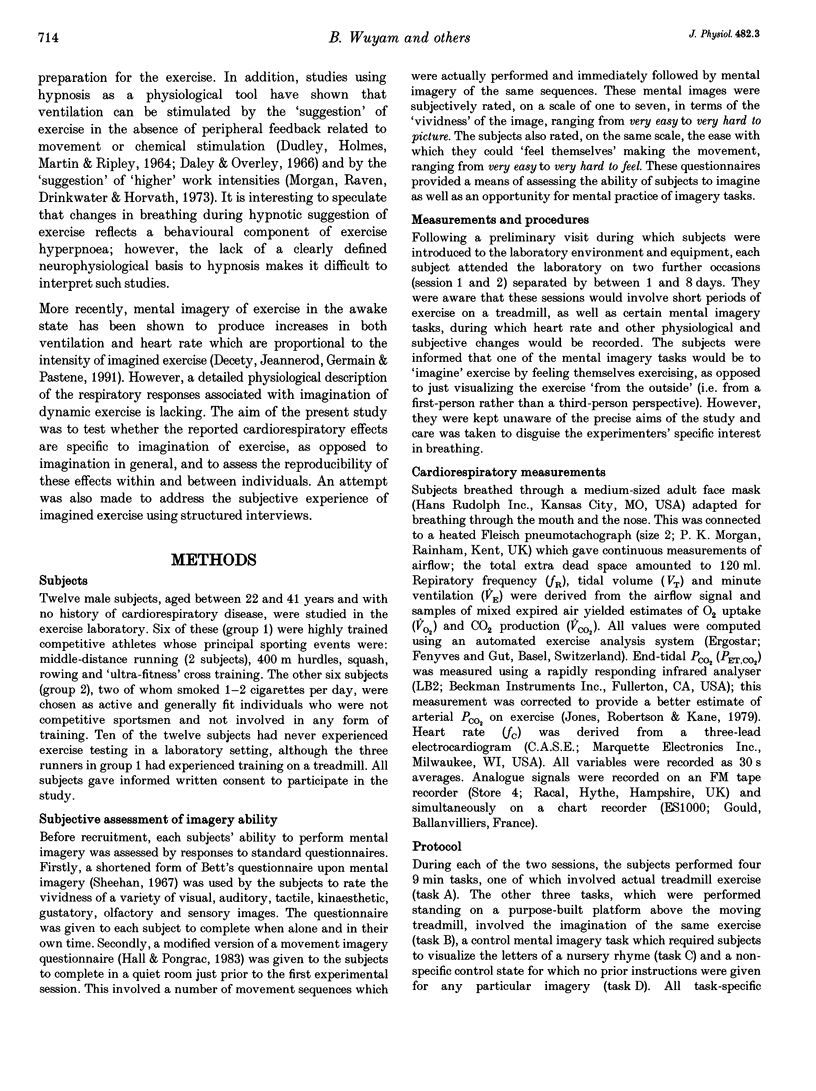
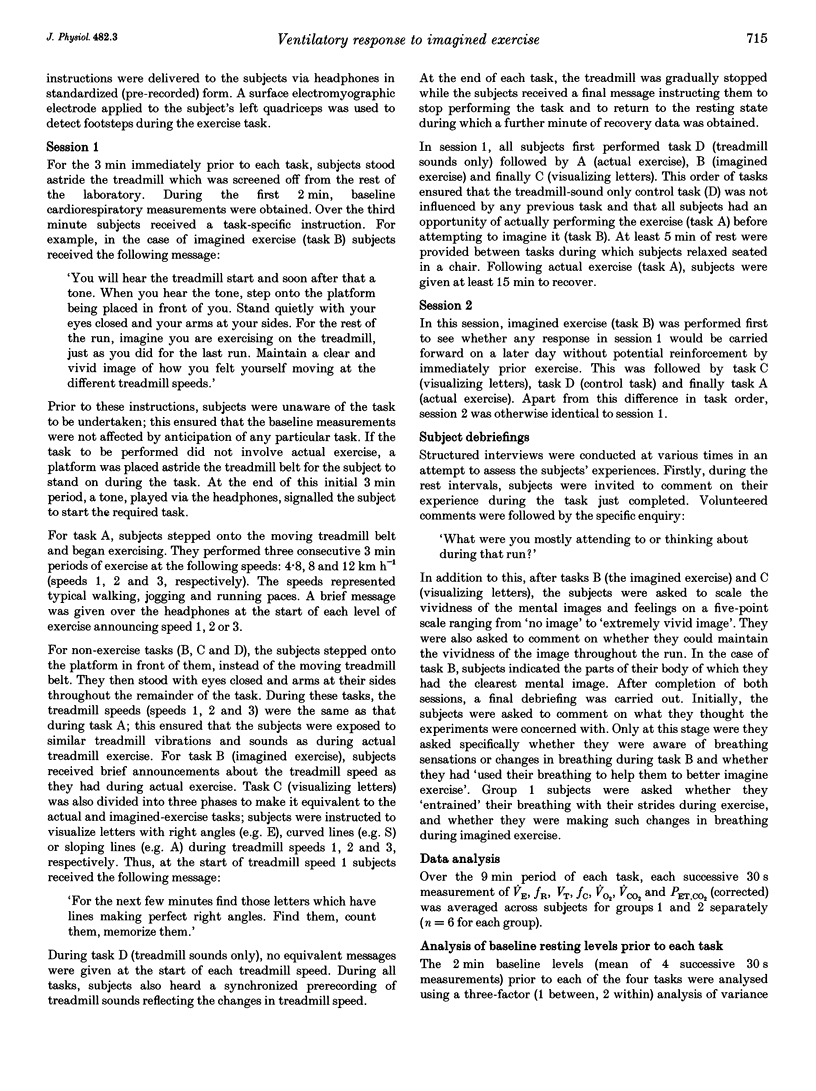
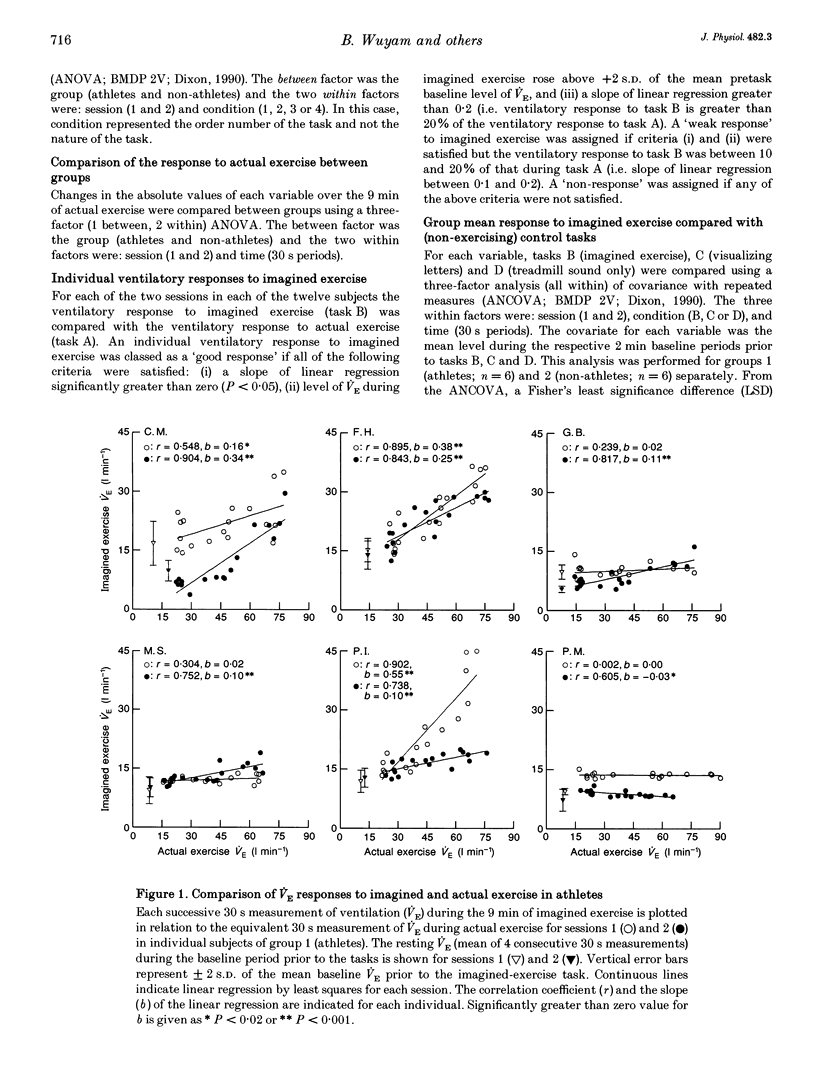
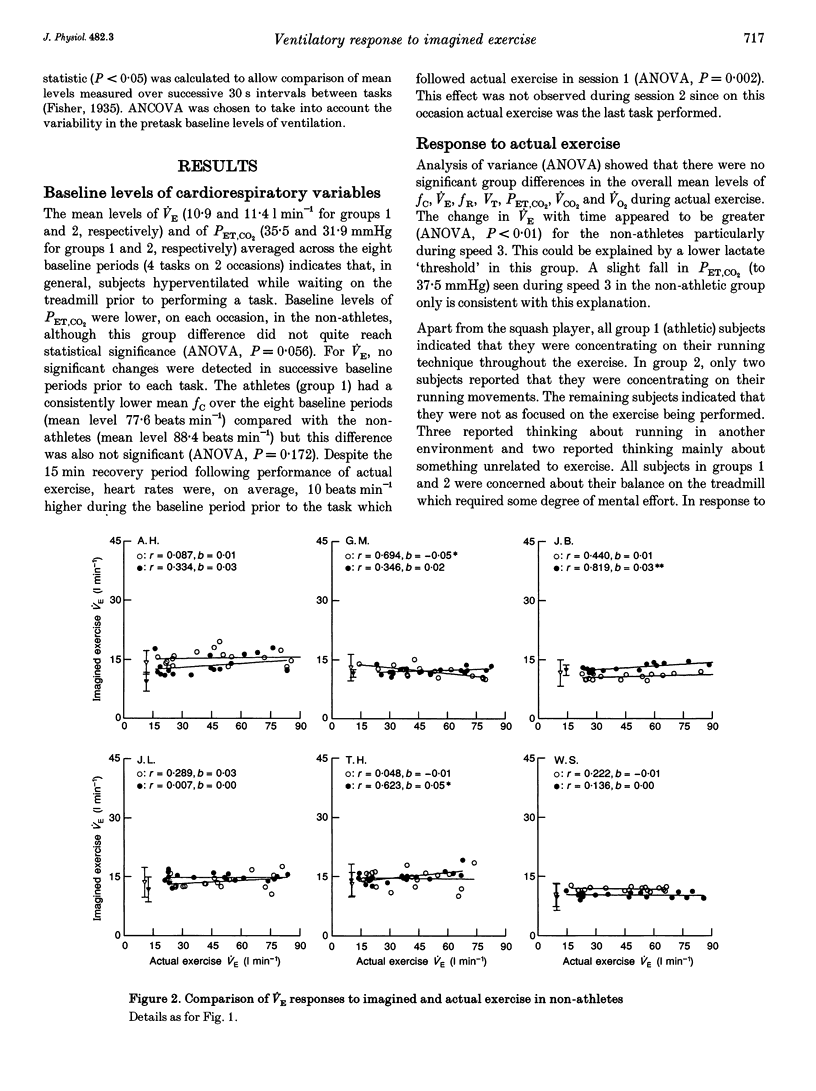
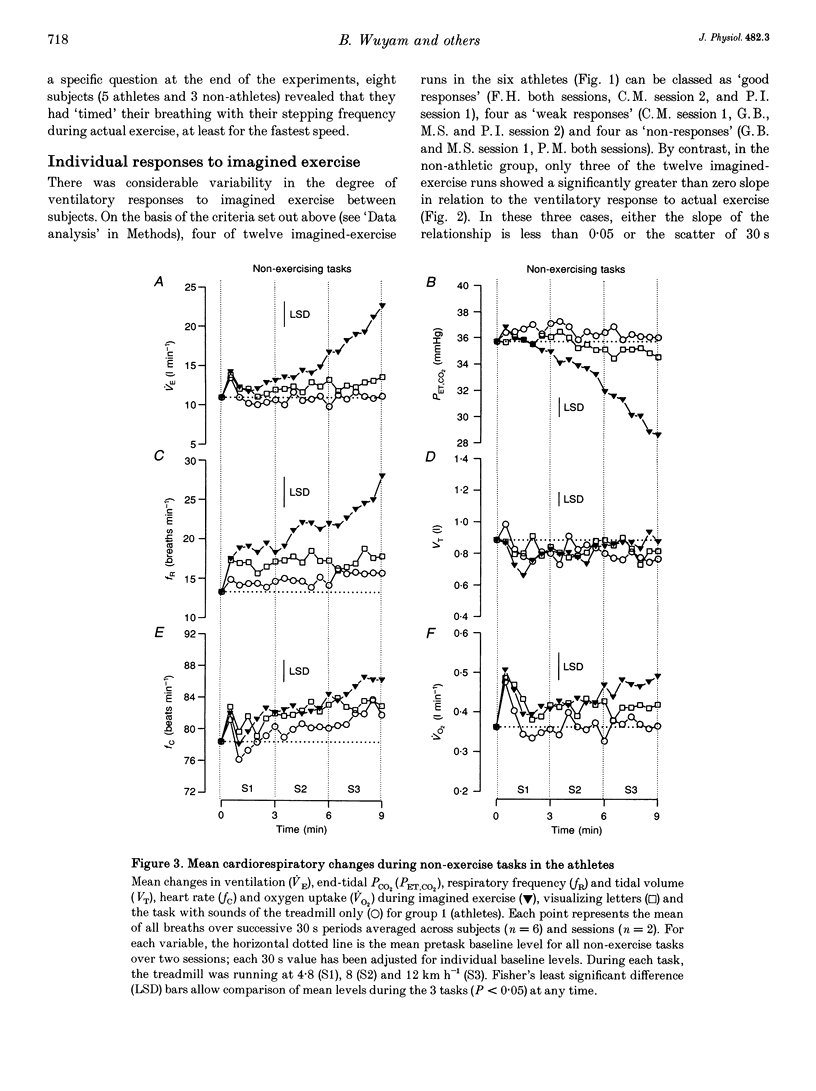
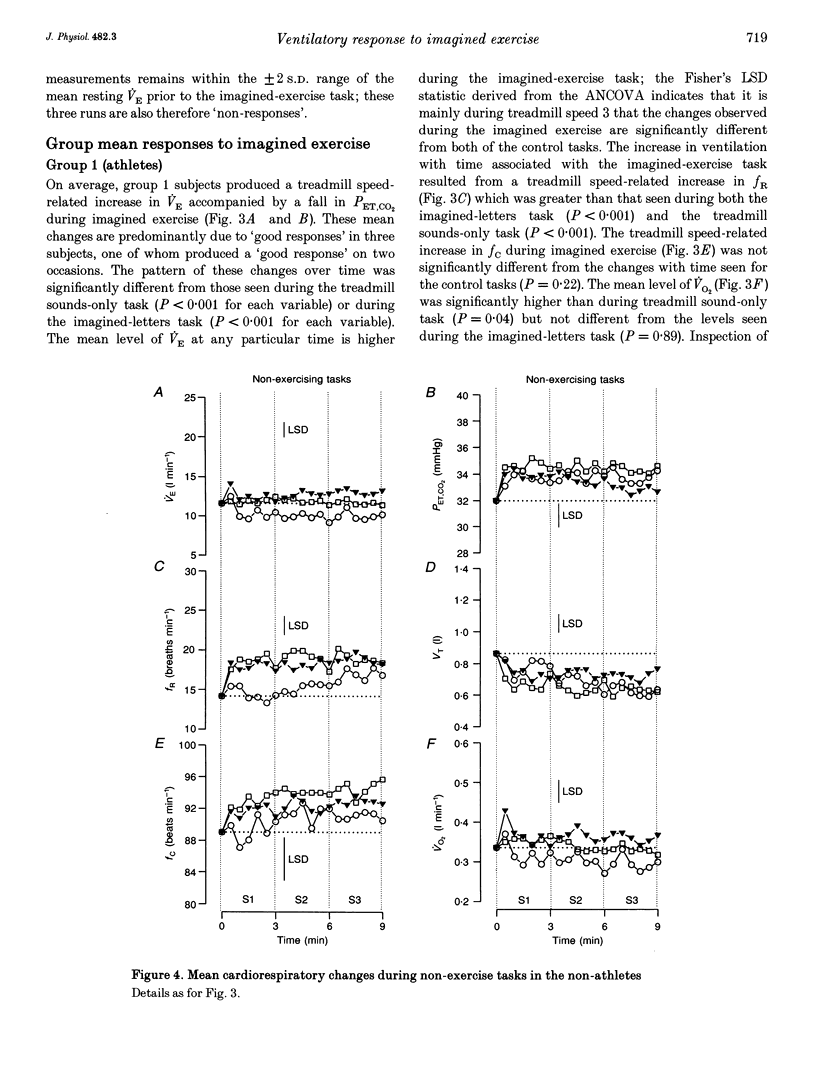
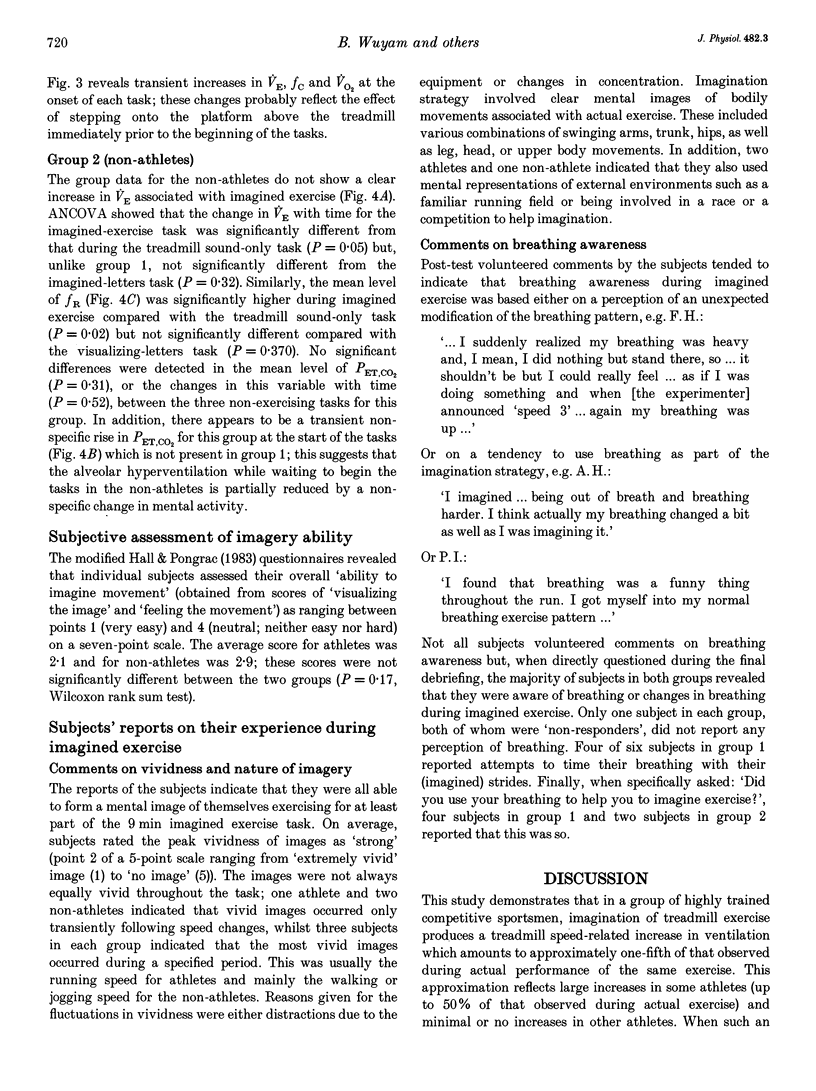
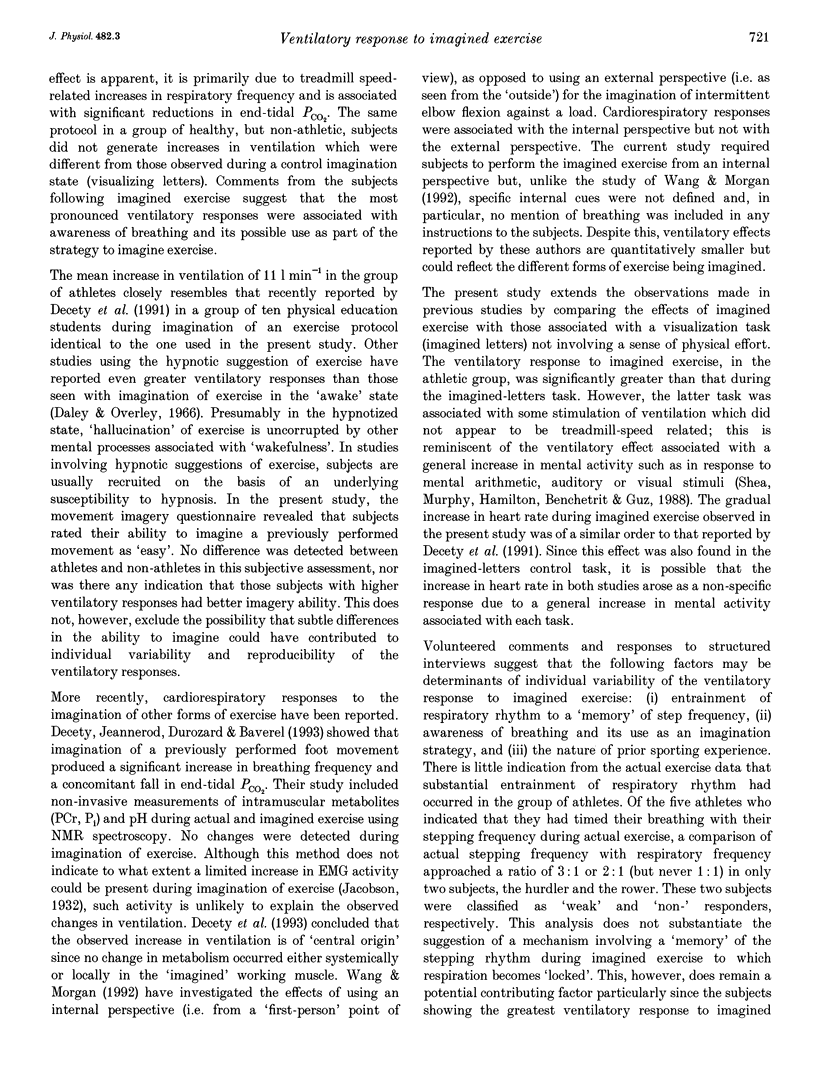
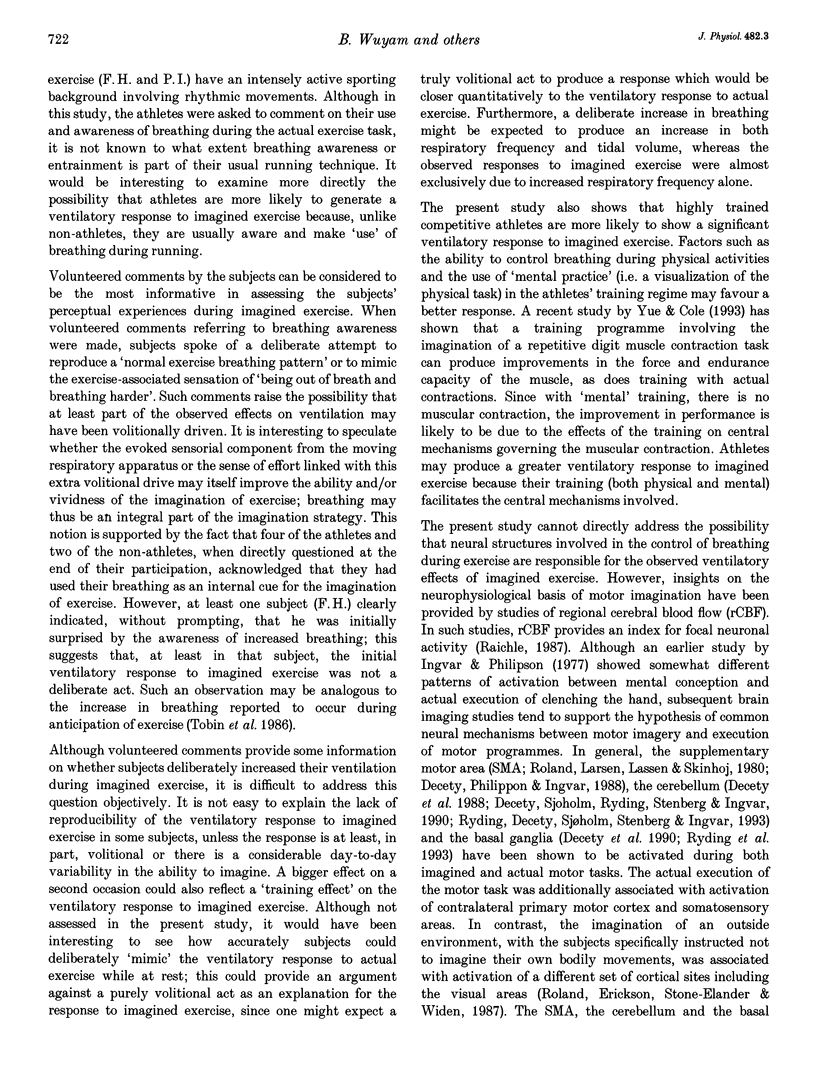
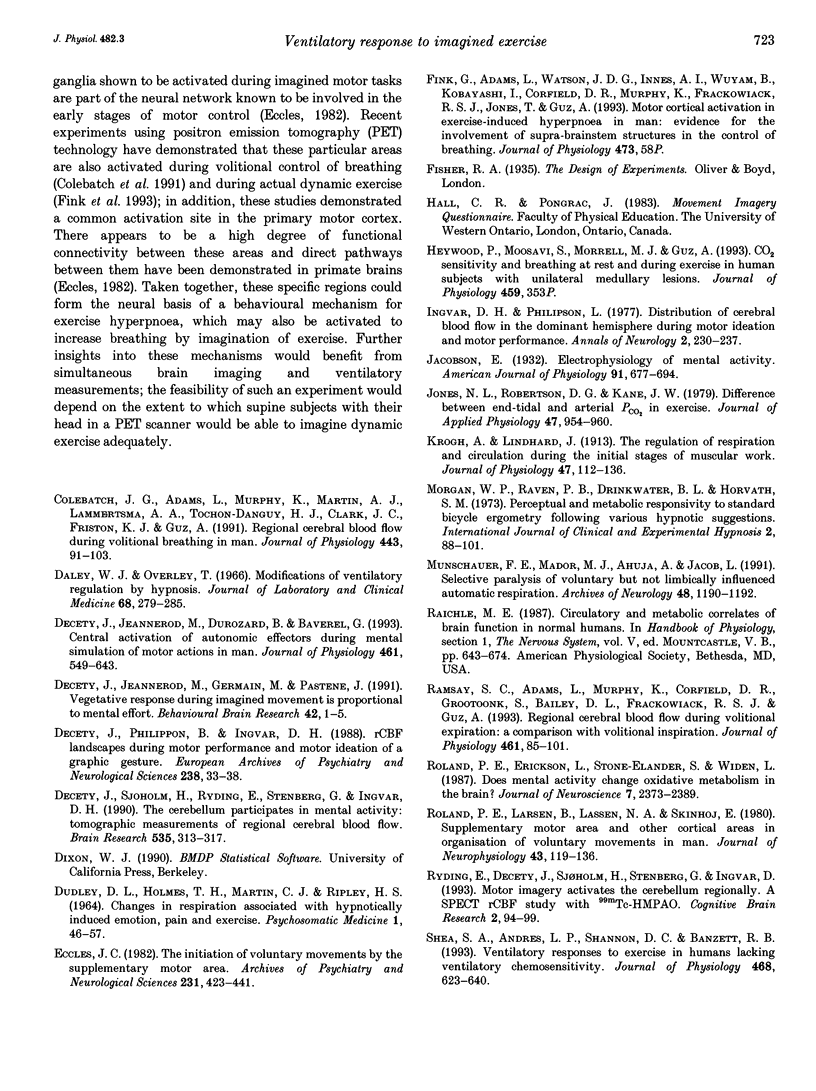
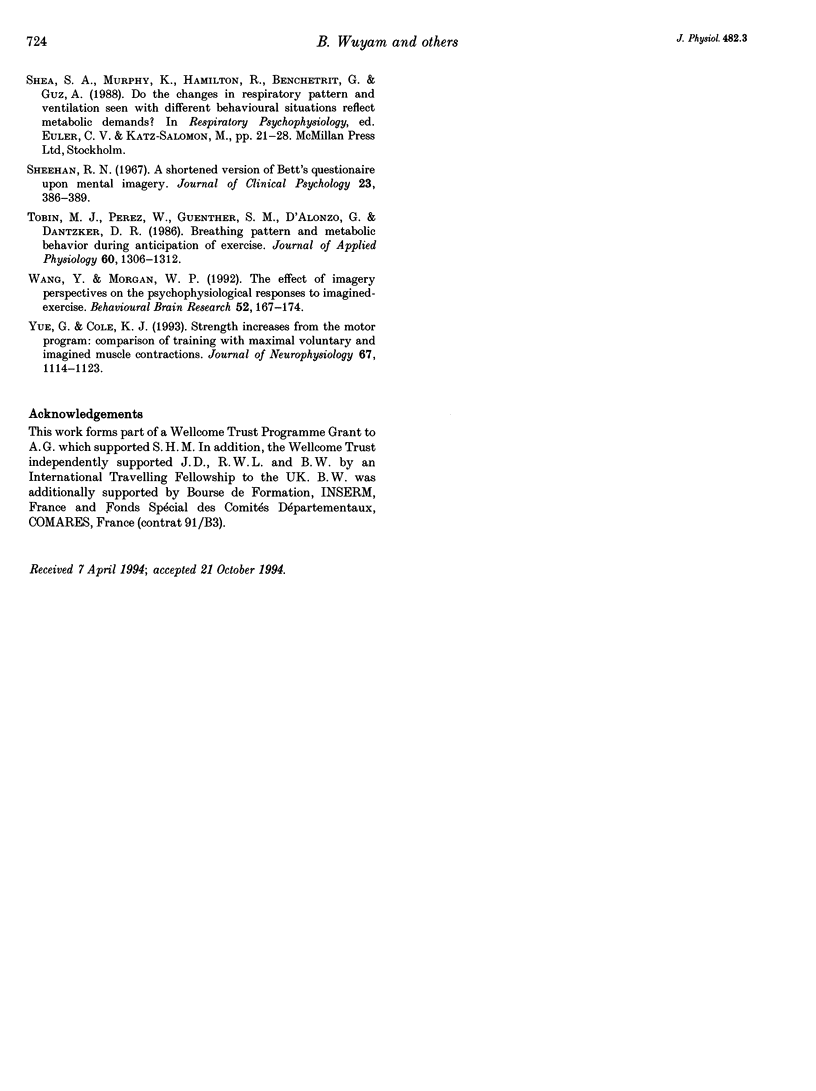
Selected References
These references are in PubMed. This may not be the complete list of references from this article.
- Colebatch J. G., Adams L., Murphy K., Martin A. J., Lammertsma A. A., Tochon-Danguy H. J., Clark J. C., Friston K. J., Guz A. Regional cerebral blood flow during volitional breathing in man. J Physiol. 1991 Nov;443:91–103. doi: 10.1113/jphysiol.1991.sp018824. [DOI] [PMC free article] [PubMed] [Google Scholar]
- DUDLEY D. L., HOLMES T. H., MARTIN C. J., RIPLEY H. S. CHANGES IN RESPIRATION ASSOCIATED WITH HYPNOTICALLY INDUCED EMOTION, PAIN, AND EXERCISE. Psychosom Med. 1964 Jan-Feb;26:46–57. doi: 10.1097/00006842-196401000-00007. [DOI] [PubMed] [Google Scholar]
- Daly W. J., Overley T. Modification of ventilatory regulation by hypnosis. J Lab Clin Med. 1966 Aug;68(2):279–285. [PubMed] [Google Scholar]
- Decety J., Jeannerod M., Durozard D., Baverel G. Central activation of autonomic effectors during mental simulation of motor actions in man. J Physiol. 1993 Feb;461:549–563. doi: 10.1113/jphysiol.1993.sp019528. [DOI] [PMC free article] [PubMed] [Google Scholar]
- Decety J., Jeannerod M., Germain M., Pastene J. Vegetative response during imagined movement is proportional to mental effort. Behav Brain Res. 1991 Jan 31;42(1):1–5. doi: 10.1016/s0166-4328(05)80033-6. [DOI] [PubMed] [Google Scholar]
- Decety J., Philippon B., Ingvar D. H. rCBF landscapes during motor performance and motor ideation of a graphic gesture. Eur Arch Psychiatry Neurol Sci. 1988;238(1):33–38. doi: 10.1007/BF00381078. [DOI] [PubMed] [Google Scholar]
- Decety J., Sjöholm H., Ryding E., Stenberg G., Ingvar D. H. The cerebellum participates in mental activity: tomographic measurements of regional cerebral blood flow. Brain Res. 1990 Dec 10;535(2):313–317. doi: 10.1016/0006-8993(90)91615-n. [DOI] [PubMed] [Google Scholar]
- Eccles J. C. The initiation of voluntary movements by the supplementary motor area. Arch Psychiatr Nervenkr (1970) 1982;231(5):423–441. doi: 10.1007/BF00342722. [DOI] [PubMed] [Google Scholar]
- Ingvar D. H., Philipson L. Distribution of cerebral blood flow in the dominant hemisphere during motor ideation and motor performance. Ann Neurol. 1977 Sep;2(3):230–237. doi: 10.1002/ana.410020309. [DOI] [PubMed] [Google Scholar]
- Jones N. L., Robertson D. G., Kane J. W. Difference between end-tidal and arterial PCO2 in exercise. J Appl Physiol Respir Environ Exerc Physiol. 1979 Nov;47(5):954–960. doi: 10.1152/jappl.1979.47.5.954. [DOI] [PubMed] [Google Scholar]
- Krogh A., Lindhard J. The regulation of respiration and circulation during the initial stages of muscular work. J Physiol. 1913 Oct 17;47(1-2):112–136. doi: 10.1113/jphysiol.1913.sp001616. [DOI] [PMC free article] [PubMed] [Google Scholar]
- Munschauer F. E., Mador M. J., Ahuja A., Jacobs L. Selective paralysis of voluntary but not limbically influenced automatic respiration. Arch Neurol. 1991 Nov;48(11):1190–1192. doi: 10.1001/archneur.1991.00530230098031. [DOI] [PubMed] [Google Scholar]
- Ramsay S. C., Adams L., Murphy K., Corfield D. R., Grootoonk S., Bailey D. L., Frackowiak R. S., Guz A. Regional cerebral blood flow during volitional expiration in man: a comparison with volitional inspiration. J Physiol. 1993 Feb;461:85–101. doi: 10.1113/jphysiol.1993.sp019503. [DOI] [PMC free article] [PubMed] [Google Scholar]
- Roland P. E., Eriksson L., Stone-Elander S., Widen L. Does mental activity change the oxidative metabolism of the brain? J Neurosci. 1987 Aug;7(8):2373–2389. [PMC free article] [PubMed] [Google Scholar]
- Roland P. E., Larsen B., Lassen N. A., Skinhøj E. Supplementary motor area and other cortical areas in organization of voluntary movements in man. J Neurophysiol. 1980 Jan;43(1):118–136. doi: 10.1152/jn.1980.43.1.118. [DOI] [PubMed] [Google Scholar]
- Ryding E., Decety J., Sjöholm H., Stenberg G., Ingvar D. H. Motor imagery activates the cerebellum regionally. A SPECT rCBF study with 99mTc-HMPAO. Brain Res Cogn Brain Res. 1993 Apr;1(2):94–99. doi: 10.1016/0926-6410(93)90015-w. [DOI] [PubMed] [Google Scholar]
- Shea S. A., Andres L. P., Shannon D. C., Banzett R. B. Ventilatory responses to exercise in humans lacking ventilatory chemosensitivity. J Physiol. 1993 Aug;468:623–640. doi: 10.1113/jphysiol.1993.sp019792. [DOI] [PMC free article] [PubMed] [Google Scholar]
- Sheehan P. W. A shortened form of Betts' questionnaire upon mental imagery. J Clin Psychol. 1967 Jul;23(3):386–389. doi: 10.1002/1097-4679(196707)23:3<386::aid-jclp2270230328>3.0.co;2-s. [DOI] [PubMed] [Google Scholar]
- Tobin M. J., Perez W., Guenther S. M., D'Alonzo G., Dantzker D. R. Breathing pattern and metabolic behavior during anticipation of exercise. J Appl Physiol (1985) 1986 Apr;60(4):1306–1312. doi: 10.1152/jappl.1986.60.4.1306. [DOI] [PubMed] [Google Scholar]
- Wang Y., Morgan W. P. The effect of imagery perspectives on the psychophysiological responses to imagined exercise. Behav Brain Res. 1992 Dec 31;52(2):167–174. doi: 10.1016/s0166-4328(05)80227-x. [DOI] [PubMed] [Google Scholar]
- Yue G., Cole K. J. Strength increases from the motor program: comparison of training with maximal voluntary and imagined muscle contractions. J Neurophysiol. 1992 May;67(5):1114–1123. doi: 10.1152/jn.1992.67.5.1114. [DOI] [PubMed] [Google Scholar]


